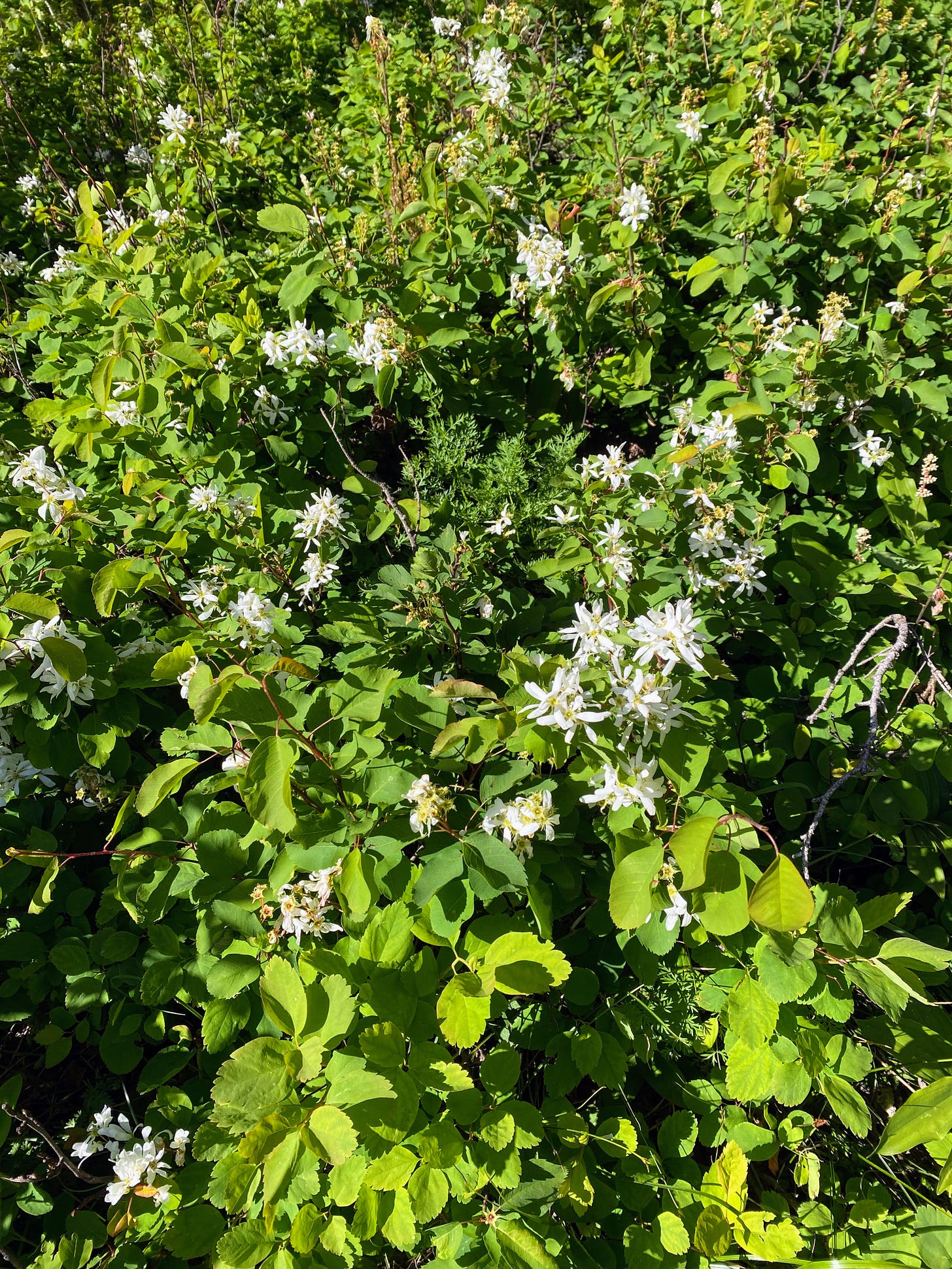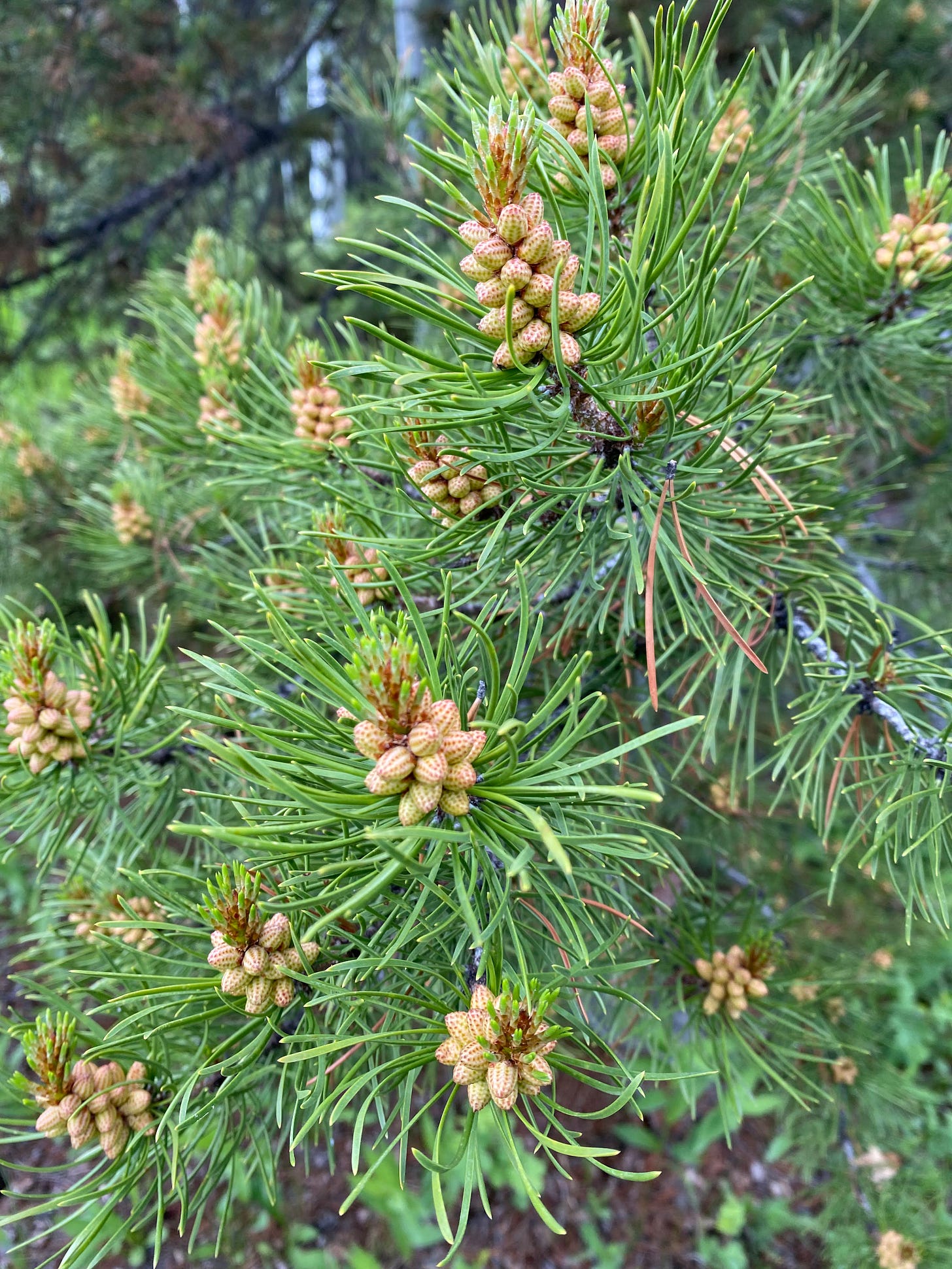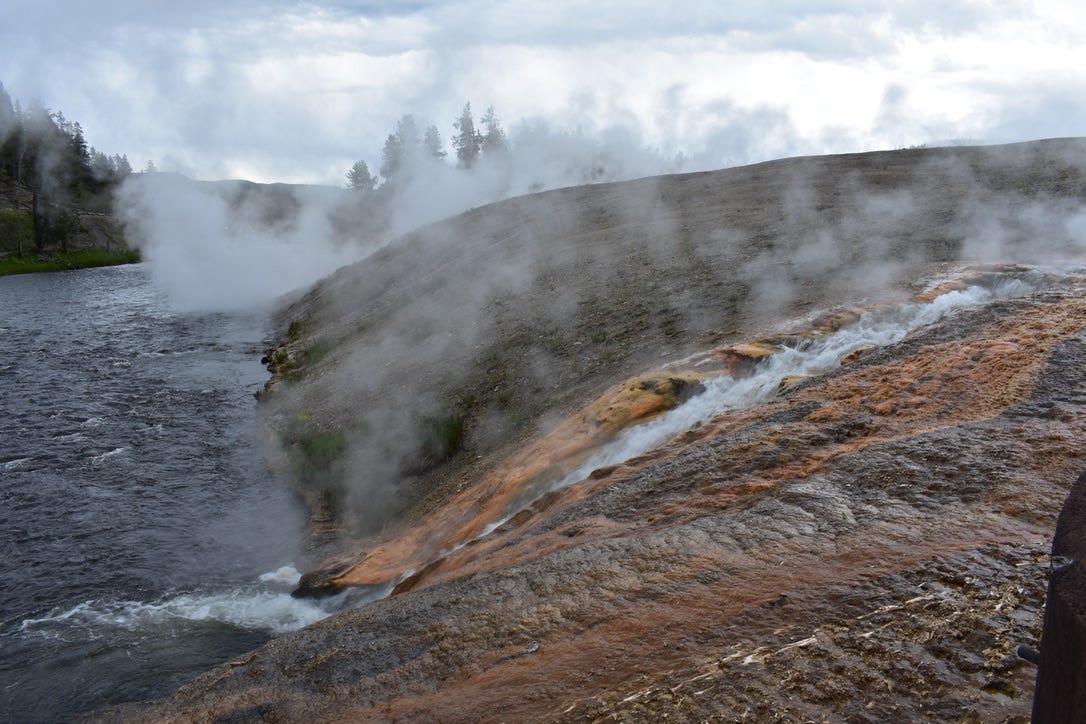A visit to Yellowstone and the Grand Tetons
A bioregional herbalist and forager's perspective on this beautiful landscape.
Antler Peak in the distance - Yellowstone National Park
I recently spent nearly two weeks in northwestern Wyoming amidst Grand Teton and Yellowstone national parks. These two areas are considerably different in the makeup of their landscape yet both startlingly beautiful no matter where you come from.
As we began our journey, the firey heat of the dry desert to the south fueled our trajectory northward. Much cooler and wetter climes awaited us in the central Rockies of Wyoming. We’d be waking up to near freezing temps with highs in the mid- to high 50s upon arrival amidst a spectacular midsummer bloom.
Amelanchier alnifolia, serviceberry - in bloom
Our approach from the south in a morning rainstorm with low hanging clouds gave all the more effect. Arriving into Jackson, the Tetons were slightly obscured but verdant hills and meadows, dripping wet with moisture, were visible all around us.
Arriving at our desired campsite several miles down a dirt road, outside of the national park and into USFS territory, we had escaped the crowds. Yet cold, the campground was still waking up and we had our pick of sites. Sunny with a view, for a change - no need for shade, so we thought. All around us serviceberry coming into flower. At the margins of the significantly sloped and mostly treeless campground were stands of lodgepole pine intermixed with aspen, all young, growing close together without much girth to them. Here and there an occasional pine 16” in width, or greater. In the shadows, beneath their generous shade were the stately flowering Solomon’s plume (Maianthemum racemosum), proud and regal. Known for its close relation to lily of the valley (Convallaria majalis), I’ve seen a few drops of the tincture of this high mountain dweller put some pep back in the step of a beleaguered lowlander who’s circulation is diminished and lungs aren’t exchanging oxygen too well. They are abundant throughout this region and such a pleasure to view on a bright, sunny morning with fresh pine-infused mountain air coursing through your lungs.
Mainanthem racemosum, Solomon’s plume (Asparagaceae)
But even more impressive, I must admit, were the almost unending roadside rows of western chokecherry (Prunus virginiana) - in flower, no less! I may go so far as to say that I saw more chokecherry flowers within these first few days than I’ve seen over the totality of the past 20 years in the Southwest - it was tremendous! Sadly, I didn’t get a photo of this wonderful display, yet I struggle to see it coming through nearly as brilliant as when it’s viewed in person. As amazing as photos and videos are these days for their clarity, nothing approximates the grandeur of Nature when experienced in person. This is a tremendous gift to contemplate on a daily basis. No matter how stark the landscape, I find there is always to be found a delicate, if not overwhelming beauty in the landscape around us when one chooses to open up the senses and take it in.
Sorbus scopulina - mountain ash, rowan
Another flowering beauty from the Rose family was in abundance in the alpine forests of the Tetons. Mountain ash, as it’s known in North America, is the traditional rowan of the Ogham calendar where it is known as Luis (pronounced like LEESH, from Old Irish). Traditions held from Ireland, Scotland, Wales, and elsewhere bestowed respect for this prized beauty of a tree which was also thought to convey spiritual protection.
Oh, Rowan tree! Oh, Rowan tree! thou'lt aye be dear to me, Intwined thou art wi' money ties, o'hame and infancy; They leaves were aye the first o'spring they flow'rs the simmer's pride, There was nae sic a bonnie tree, in a' the countrie side. (From The Book of Scottish Song, 1843)
…and on it goes this rhythmic tribute to the rowan and all the beauty it offers the senses. Yet the rowan is also viewed reverently by those who sought spiritual insight or protection. One practice was to gather up a bundle of rowan sticks to be placed above the doorway on the eve of Imbolc (St. Bridgit’s Day), Feb. 2, to protect all dwellers therein from the remnants of winter darkness that brought bleakness and hunger to the countryside.
This is the herb of herbs, so to speak, as its name - Luis, or Lus - is the Irish word for herb itself. In fact, a more modern Irish word is luibh (pronounced much like “leaf” in English) used to refer to a culinary or therapeutic herb. In either case, it has at its root, Lu, which denotes “light” or “fire” and is cognate with the Irish hero Lugh, or Lú, Lamhfada (“of the long hand”). Known to be skilled in all the arts (“Sámildanach”), Lugh had mastered the “fire in the mind” or his connection to the creative inspiration. Luis, or Rowan, refers to this same radiance not only from within but that which exists in the world around us, the world of Nature, which serves to inspire us and guide us towards a life of honor and integrity. Lugh himself was known for his just approach to all he served and was bound by any oath he himself had committed to, but he was not without his own cleverness and crafty maneuvering. Like Lugh, Luis represents keen discernment and objectivity due to a thorough understanding and acceptance of our thoughts and the influences of our emotional mind body.
After getting acclimated for a couple days, I went out on a brief foraging exploration. I wasn’t sure what I’d find but I like to just roam about in a new place. Saying hello to the arnica and a few mushrooms on the wet hillside beside the road, I followed my nose down a trail where I came upon a mostly shaded lodgepole pine a little ways above a cliff face overlooking the Gros Ventre River. Its boughs were laded with staminate cones (clusters of pollen containing cones) at the branch tips, abundantly growing at my height and lower!
lodgepole pine (Pinus contorta) pollen cones
You can see in the photo above the abundance of pollen cones clustered together. They are still fresh and moist and have only barely begun to open at this stage - my preference for gathering). Grateful for this find, I took a moment to offer my gratitude out of respect for what this life has to offer in abundance. The power of nature to replicate itself and to take what the Earth and the Sun offer us and produce abundant food and beauty is something that’s present within each of us. It takes time to connect with this feeling once we have become disconnected, but it is there within us nonetheless.
Pine, another tree situated within the Ogham language, is similarly firey as the rowan, but in a different way. Pine connects with our systemic circulation, our metabolism, our carnal nature, and with this energy harnessed and channeled appropriately it promotes self-awareness and spiritual development. This tree, I believe, was a significant teacher for the Druids (‘followers of the oak’), and it (Pinus sylvestris) once covered much of Ireland many thousands of years ago. The symbol within the Ogham representing pine, or Ailm, is very similar to today’s Christian cross. The ancient Celtic cross may have been derived from this primitive symbol (by primitive, I mean primary) which evokes the knowledge of the Circle of Life and the human being’s place within it.
I will be teaching a 1-day workshop on the Ogham language as a cosmology, a means to relate more deeply to the natural world, and a method of divination in my upcoming Becoming a Bioregional Herbalist field study taking place in Oak Creek Canyon near Sedona, AZ on Sep. 20-23, 2023. Consider joining me in the forest with the wild plants to celebrate the autumnal equinox this year!
The landscape in Yellowstone is often surreal. Reports brought back to the east coast population in the mid-19th century were regarded as preposterous and outright lies. No one could believe such stories about the splendor and the dramatic scenery of the ground bursting out with steam in multiple locations across a vast landscape teaming with wildlife.
hot waters dumping into the Firehole River
I don’t think my captured images do the landscape much justice. Frankly, I was more focused on taking it in with my senses than recording snapshot images, but there were moments that I was compelled to grab the camera for the hike.
Grand Canyon of the Yellowstone
hot spring near the shore of Lake Yellowstone
The textures of the earth were often stunning…
Grand Prismatic spring
I felt at home hiking through lush alpine forests and across remote meadows on my way to visit some beaver ponds. Along the way a sudden morning shower ensued and I was able to enjoy it, peacefully, seated beneath the protection of an old Douglas fir, reclined against its stalwart trunk. The subtle exhilaration of the quiet and quick storm put me in the mood to quietly commune with the landscape, observing, breathing it in, allowing myself to simply be. This is the way, I’ve found, to restore the human spirit once abraded and bedraggled by the excoriating forces of our modern world. The many subtle yet deliberate ways the forest, the mountain air, the vibrations of flowing, wild water tend to work on the human body, and its psyche, run deep as we allow them time to do so.
All in all, this region is a veritable paradise for the herbalist, forager, angler, hunter - especially this time of year. The landscape is teeming with life. Of course, this was a landscape the free people of the Earth once visited on their summer sojourns to fish, trap, hunt, and forage. I could only imagine what it would be like to witness this landscape 200 years ago.













Appreciate this share, wow 2 weeks in Wyoming! Appreciate all the plants you shared (except, for some reason, Choke Cherry Blossoms are my kryptonite)